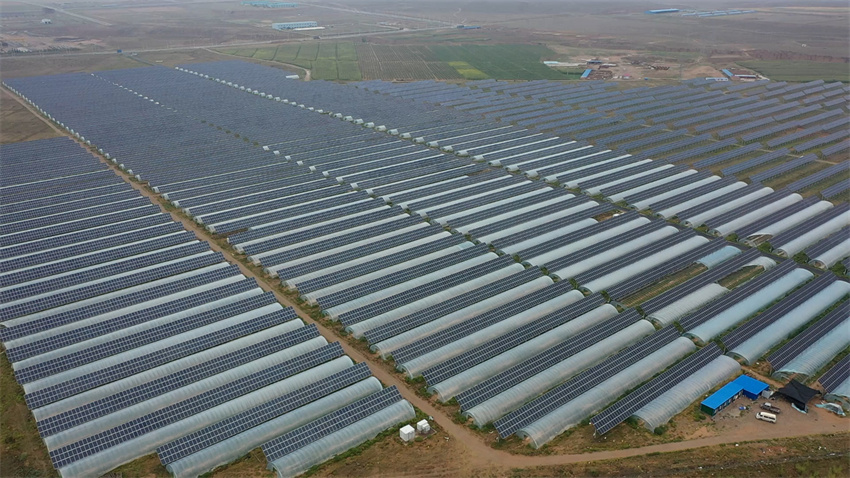Ningxia-Hunan project paves way for development cooperation
A model green energy transmission project is gearing up to showcase crucial cooperation between provinces and regions, in line with national efforts toward sustainable growth for the next major stages of development.

A regional economic cooperation symposium involving Ningxia Hui autonomous region and Hunan province is held in Yinchuan on Feb 20. [Photo by Zuo Mingyuan]
The project involves Northwest China's Ningxia Hui autonomous region and Central China's Hunan province, with a major economic cooperation symposium in Ningxia's regional capital Yinchuan on Feb 20 marking its rollout.
Chen Run'er, secretary of the Party committee of Ningxia and director of the standing committee of the regional people's congress, said that the power transmission project will be used as a major engine to accelerate the construction of the pilot area, drive economic structure optimization, industrial transformation and upgrading, and fuel high-end green, intelligent and integrated progress covering the ecological protection and sustainable development of the Yellow River Basin area.

The new energy site in Hongsibao district of Ningxia in June 2021. [Photo by Kang Guoqing]
Mao Weiming, deputy secretary of the Hunan Provincial Party Committee and provincial governor, led a team to the project sites marking out the model for cooperation between the central and western regions in the new era.
Ningxia, a major energy production base with rich coal deposits and abundant wind, solar and other green resources, is seen as a fitting partner for Hunan, which has an external energy dependence rate of up to 80 percent. The latest power transmission project receives strong support from the National Development and Reform Commission, the National Energy Administration and the State Grid, being included in the energy development plan under the 14th Five-Year Plan (2021-25) period and becoming one of its nine key inter-provincial and inter-regional power transmission channels.

Workers set up new energy facilities in February 2022. [Photo by Kang Guoqing]
The project's transmission links pass through six provinces, autonomous regions and municipalities, across Ningxia, Gansu, Shaanxi, Chongqing, Hubei and Hunan, with a total length of nearly 1,500 kilometers. It will deliver 40 billion kWh to 44 billion kWh of electricity annually – translating into an increase of about one-sixth of Hunan's electricity needs when put into operation by the end of the 14th Five-Year Plan (2021-25).

The Hongsibao new energy site in January 2022. [Photo by Wang Yefu]
The project involves clean energy such as Ningxia's wind and solar resources, initially covering the construction of facilities for generating at least 9 million kilowatts of solar power and 4 million kilowatts of wind power. The capabilities are in line with country's green, low-carbon development goals – to have CO2 emissions peak before 2030 and achieve carbon neutrality before 2060 – and seen as an important engine and support for the in-depth cooperation of new energy industries.

Solar energy panels and equipment at the Hongsibao site in September 2021. [Photo by Kang Guoqing]
Involving the Xiangning new energy equipment manufacturing industrial park in Hongsibao district of Wuzhong in Ningxia, the project, a new energy industry cluster boasting complete upstream and downstream industrial chains, is also set to be a significant boost to the local economy, helping about 230,000 needy residents.

Construction of facilities at the Xiangning new energy equipment manufacturing industrial park in Hongsibao of Ningxia in February 2022. [Photo by Wang Yefu]
The industrial park, which brings together Ningxia's energy resources with Hunan's industrial advantages, has recorded a total investment of 3 billion yuan and an expected total output value of 13 billion yuan, covering more than 20 major enterprises so far, with development plans ranging from photovoltaic modules to high-efficiency cell products.

Construction work at the new energy site in February 2022. [Photo by Wang Yefu]
Ningxia's Hongsibao new energy site itself is part of a national electric power, multi-energy complementary demonstration base, with major development framework agreements inked. The first phase of a leading photovoltaic project alone covers a total annual investment of 1.2 billion yuan, with construction scheduled to start in the first half of this year and a 300MW photovoltaic power station and supporting energy storage facilities built within the year.

The Hongsibao new energy site in June 2021. [Photo by Kang Guoqing]
The moves are aimed at building Hunan's new energy and supporting industry capabilities in Ningxia to help leading energy enterprises' involvement in the investment, development and utilization of regional wind and solar resources, according to officials.
Contact the writer at hudongmei@chinadaily.com.cn

 Yinchuan Wine-producing Area at the eastern foothills of Helan Mountains
Yinchuan Wine-producing Area at the eastern foothills of Helan Mountains A promising Sci & Tech center in NW China
A promising Sci & Tech center in NW China Party building stories in Yinchuan's Xixia district
Party building stories in Yinchuan's Xixia district